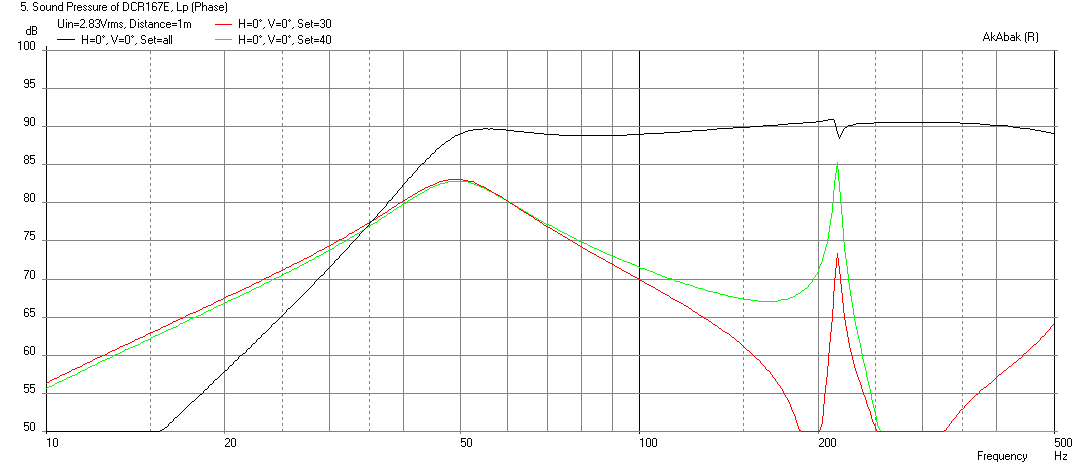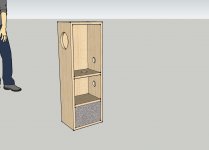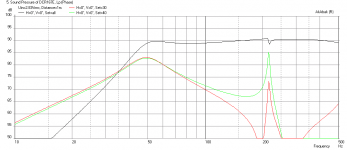Hi gents,
I am new here 😀 and glad to be in great company!
Having recently acquired an old Pioneer 6BM8 tube amp (SA400) which is being restored... I have been looking for an efficient speaker to pair it with. After hearing some FE166 in BLH a few months back I have also been wanting to try a Full Ranger being shocked at the imaging from these horns.
As my living space is limited I have settled on trying to get the most out of a Fostex FF165WK in a BR box.
Just hoping for any advice and or tweak suggestions for any changes I can make to the basic Fostex BR box design, in terms of port tuning, port dimensions, cabinet damping, construction etc... basically I need some vaildation that I am on a good path here! 🙂
https://www.madisoundspeakerstore.com/approx-6-fullrange/fostex-ff165wk-6.5-full-range/
I am new here 😀 and glad to be in great company!
Having recently acquired an old Pioneer 6BM8 tube amp (SA400) which is being restored... I have been looking for an efficient speaker to pair it with. After hearing some FE166 in BLH a few months back I have also been wanting to try a Full Ranger being shocked at the imaging from these horns.
As my living space is limited I have settled on trying to get the most out of a Fostex FF165WK in a BR box.
Just hoping for any advice and or tweak suggestions for any changes I can make to the basic Fostex BR box design, in terms of port tuning, port dimensions, cabinet damping, construction etc... basically I need some vaildation that I am on a good path here! 🙂
https://www.madisoundspeakerstore.com/approx-6-fullrange/fostex-ff165wk-6.5-full-range/
Last edited:
To get the most from your speakers you will need stands if you build 'monitor' style cabinets. My bias is toward TQWT floor standers, like a Metronome. Mets don't take up much floor space & have high WAF.
Cheers, Jim
Cheers, Jim
I think you'll be fine simply building them to the suggested dimensions. A simple BR with a nice full range driver can be a beautiful thing! 😀 (how's that for validation?😉)
IME a TQWT or conical TQWT (like the metronome) will typically sound bigger, cleaner and more hifi than a typical reflex box. So I guess i agree with Jim, and he makes a good point about floor space. However, a reflex can sometimes be mellower sounding, more forgiving of mediocre source material, and generally quite enjoyable.
IME a TQWT or conical TQWT (like the metronome) will typically sound bigger, cleaner and more hifi than a typical reflex box. So I guess i agree with Jim, and he makes a good point about floor space. However, a reflex can sometimes be mellower sounding, more forgiving of mediocre source material, and generally quite enjoyable.
I don't pay much attention to the FOstex recommended boxes. I am currently listening to a set of solid wood prototypes for the FF165wk compact floorstander (ie Fonken165 CFS). I am very please with them.
more: http://www.diyaudio.com/forums/plan...oorstander-intro-questions-3.html#post4119082
dave
more: http://www.diyaudio.com/forums/plan...oorstander-intro-questions-3.html#post4119082
dave
Drawings are part of the FF165wk paid planset.
http://www.diyaudio.com/forums/plan...10-hifi-minionken-plan-set-subscriptions.html
dave
http://www.diyaudio.com/forums/plan...10-hifi-minionken-plan-set-subscriptions.html
dave
I am going ahead with Bass Reflex boxes for now and may build something more ambitious when space and time permits.
A few questions for the Bass Reflex cab.. how much and what kind of damping/filler is beneficial?
Also I gather stands are the way to go but wondering if anyone else has experience with Sorbothane half spherical feet to decouple the cabinet from what it is standing on? I have been using these with my AR18s and they seem to have a marked positive effect overall.
Hoping to have my drivers here by Xmas.. 18m BB is being cut this week and my Pioneer amp is recapped and sounding sweet.. just a few more carbon comp resistors to be replaced now... 🙂
A few questions for the Bass Reflex cab.. how much and what kind of damping/filler is beneficial?
Also I gather stands are the way to go but wondering if anyone else has experience with Sorbothane half spherical feet to decouple the cabinet from what it is standing on? I have been using these with my AR18s and they seem to have a marked positive effect overall.
Hoping to have my drivers here by Xmas.. 18m BB is being cut this week and my Pioneer amp is recapped and sounding sweet.. just a few more carbon comp resistors to be replaced now... 🙂
Wow, AR18s! I had AR15s and AR92s. I am very familiar with AR speakers since they were among my favorite brands back in the 70s and 80s.
You will really enjoy the Fostex sound if you are like me. It's brighter than the AR and the details come thru without straining your ears to hear them. You will also notice a more realistic tone to the instruments and a more expressive midrange.
It's all good if it helps you enjoy the music.
You will really enjoy the Fostex sound if you are like me. It's brighter than the AR and the details come thru without straining your ears to hear them. You will also notice a more realistic tone to the instruments and a more expressive midrange.
It's all good if it helps you enjoy the music.
I am going ahead with Bass Reflex boxes for now and may build something more ambitious when space and time permits.
A few questions for the Bass Reflex cab.. how much and what kind of damping/filler is beneficial?
Covering 3 sides with ~1/2" thick carpet felt or similar material is a good starting point. Typically, this would be the back, top, and one side. You can use more or less to taste. More damping tends to clean up the mids, but too much tends to make the sound gray and lifeless.
Also I gather stands are the way to go but wondering if anyone else has experience with Sorbothane half spherical feet to decouple the cabinet from what it is standing on? I have been using these with my AR18s and they seem to have a marked positive effect overall.
It really depends, but big soft gooey feet aren't a good idea for smaller cabinets IME. There isn't enough mass for the driver to react against, and you'll lose some bass. Small semi hard rubber feet (or spikes if on carpet) work better. With bigger heavier cabinets, soft rubber feet can be useful. Easy enough to try for yourself anyhow.
Hoping to have my drivers here by Xmas.. 18m BB is being cut this week and my Pioneer amp is recapped and sounding sweet.. just a few more carbon comp resistors to be replaced now... 🙂
Aw, nuthing like recapping old amps...! good play to just replace everthing. It's not worth it to chase down the bad ones. 🙂 Are you replacing the resistors with new carbon comps? They have a subtly different sound than metal oxide.
Thanks Greg B, I think we are constructing our cabinets so the rear baffle will be removable and then can experiment with damping materials a bit. Will also try different feet, did not occur to me that the Sorbothane might absorb too much energy and effect bass response!
I have done all the film and electrolytic caps in the 1969 Pioneer but settled on carbon film resistors.. only about 20 more to go!
Not too bad under there compared to some of the receivers from this period:
 DSC_0321 by bregtje_lush, on Flickr
DSC_0321 by bregtje_lush, on Flickr
I have done all the film and electrolytic caps in the 1969 Pioneer but settled on carbon film resistors.. only about 20 more to go!
Not too bad under there compared to some of the receivers from this period:
 DSC_0321 by bregtje_lush, on Flickr
DSC_0321 by bregtje_lush, on FlickrAnother option for you to consider is a double bass reflex or dual chamber reflex. This design suppresses cone excursion across two octaves and will reduce movement-related distortion. They're dead easy to design. Given that the FF165 looks as though it needs around 20-25L volume, I would design a floorstander as follows: calculate for about a cubic foot volume; divide the whole cabinet in half with a horizontal divider, then divide the bottom chamber in half again. The top compartment is the main compartment housing the driver and is about 14L in volume, the two compartments below are 7L. The top two compartments are connected via a port and then ported to the outside as usual for a dual chamber reflex, and then you fill the bottom compartment with sand to increase stability and reduce cabinet vibrations.
Attachments
Hi,
Sadly DBR's don't work as advertised by Weems.
I say "advertised" because there is no analysis,
just rules and conjecture about how it works,
which is simply wrong, and graphs about what
it theoretically does which are just plain wrong.
The reality is the top port will dominate, and
an octave lower depressurise the top volume,
so there is no drive for the lower two ports
and extra volume, which do next to nothing.
Weems write up is triumph of wrong assumptions
and claims, it ends up just a badly tuned box.
There is no chance of excursion supression at
the lower claimed tuning at all, its just wrong.
rgds, sreten.
Sadly DBR's don't work as advertised by Weems.
I say "advertised" because there is no analysis,
just rules and conjecture about how it works,
which is simply wrong, and graphs about what
it theoretically does which are just plain wrong.
The reality is the top port will dominate, and
an octave lower depressurise the top volume,
so there is no drive for the lower two ports
and extra volume, which do next to nothing.
Weems write up is triumph of wrong assumptions
and claims, it ends up just a badly tuned box.
There is no chance of excursion supression at
the lower claimed tuning at all, its just wrong.
rgds, sreten.
Last edited:
A dual chamber reflex if properly designed has balanced output from the upper and lower chambers. Requires modeling in akabak or similar program though. Cone excursion isn't that much reduced compared to single chamber reflex though.
Here is a DCR that is 18in tall x 14in deep x 8.5in wide (internal dimensions), divided in 2:1 volume as described above. This DCR is fitted with an FE167E through a 7ohm and 1.0mH BSC filter. Vents are slot vents for top and bottom at 10cm wide x 0.5cm high x 114cm long, internal vent between chambers is 2in dia hole drilled in 0.5in thick ply.
Freq response produces nice deep bass at 50Hz:

Cone displacement at 2.83v - needs a high pass filter below 40Hz if you have content there:

Edit: Pure conjecture? DCR's are easily modeled in Akabak, and it's not all simulations. I have designed and built them and the model predicts the response quite well. Look here if you want more info:
http://www.diyaudio.com/forums/full-range/252627-viva-la-vifa-curvy-cabinet-dcr-tc9fd.html
Here was predicted response from main and each vent:

Here was measurement (look at shape of green and pink curves compared to model):

Here is a DCR that is 18in tall x 14in deep x 8.5in wide (internal dimensions), divided in 2:1 volume as described above. This DCR is fitted with an FE167E through a 7ohm and 1.0mH BSC filter. Vents are slot vents for top and bottom at 10cm wide x 0.5cm high x 114cm long, internal vent between chambers is 2in dia hole drilled in 0.5in thick ply.
Freq response produces nice deep bass at 50Hz:

Cone displacement at 2.83v - needs a high pass filter below 40Hz if you have content there:

Edit: Pure conjecture? DCR's are easily modeled in Akabak, and it's not all simulations. I have designed and built them and the model predicts the response quite well. Look here if you want more info:
http://www.diyaudio.com/forums/full-range/252627-viva-la-vifa-curvy-cabinet-dcr-tc9fd.html
Here was predicted response from main and each vent:

Here was measurement (look at shape of green and pink curves compared to model):

Attachments
Last edited:
A dual chamber reflex if properly designed has balanced
output from the upper and lower chambers.
Hi,
That is pure misleading conjecture. There is no way to
"properly" design a DBR to achieve that stated goal.
It doesn't work as described by Weems, and can't.
Its just something that would be worthwhile if it
worked as claimed, but it doesn't, and has no merit.
Be my guest to try to model it "properly".
rgds, sreten.
Its not a lot different to fitting two ports tuned an
octave apart to a single box, and claiming done
properly both will give equal output, they don't.
Last edited:
It is a nice driver. I heard it in the Fostex ready made enclosure (Japanese market only) for it (which If I am not mistaken has the same size as the plan, for youth check). Balanced and nice. the FF165 sounds more balanced than the FE166, but the fact is that it may have just not enough treble for you, depending on what you like. Then you can add a supertweeter.
I must say that the FF225WK was very good in the ready made enclosure, but that one really needs a tweeter.
I must say that the FF225WK was very good in the ready made enclosure, but that one really needs a tweeter.
Hoping the FF165 will be sweet enough in the mids for me to not miss the bass extension or the highs too much. I guess its all compromises!
Re DCRs, a mild point to make: George Augspurger first proposed these (although I imagine WE / RCA etc. will have tried it some decades before) in his 'Double Chamber Speaker Enclosure' article in the December edition of Electronics World, 1961. He also provided measurements of the finished enclosure with a couple of different drivers. Dated, yes, but not devoid of merit, as might be expected. Claudio Negro also has measurements of his DCR showing behaviour roughly consistent with what Weems / Augspurger etc. note in his AudioXpress article of 2005.
DCRs work OK. I built a couple / tried a couple myself about 2 years back with my mate Colin for the sake of interest, & did a little one here for the Fostex FF85wk (Harpoon). As noted, they don't generally reduce excursion much, although that partly depends on the alignment & tuning frequency[ies]. I don't generally bother but they're valid enough, though they don't provide major advantages & have their own caveats.
DCRs work OK. I built a couple / tried a couple myself about 2 years back with my mate Colin for the sake of interest, & did a little one here for the Fostex FF85wk (Harpoon). As noted, they don't generally reduce excursion much, although that partly depends on the alignment & tuning frequency[ies]. I don't generally bother but they're valid enough, though they don't provide major advantages & have their own caveats.
Last edited:
- Status
- Not open for further replies.
- Home
- Loudspeakers
- Full Range
- Any advice for my first build - Bass Reflex Fostex FF165


